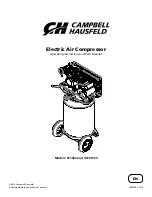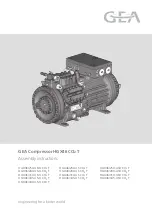
FP2021
17 Sp
4
Portable Air Compressors
4. Fully counterclockwise will shut off flow
of air completely.
REGULATED OUTLET GAUGE
1. This gauge shows at-a-glance, air
pressure at outlet. Air pressure is
measured in pounds per square inch
(psi).
2. Be sure this gauge reads ZERO before
changing air tools or disconnecting hose
from outlet.
TANK PRESSURE GAUGE
Gauge shows pressure in air receiver
indicating compressor is building pressure
properly.
Release all
pressure and
disconnect power before making any
repair.
1. Check compressor for any visible
problems, especially check air filter to be
sure it is clean.
!
WARNING
2. Pull ring on safety valve and allow it to
snap back to normal position.
Safety valve must
be replaced if it
cannot be actuated or it leaks air after ring
is released.
3. With compressor shut off reduce tank
pressure below 10 psi, then drain
moisture from tank daily to avoid tank
corrosion. Drain moisture from tank by
tilting the tank and opening the drain
cock underneath the tank.
4. Turn power OFF and clean dust and dirt
from motor, tank, air lines and pump
cooling fins.
NOTE:
This unit has no air filter to
maintain.
!
WARNING
IMPORTANT:
Unit should be located as far
from spraying area as hose will allow.
LUBRICATION
This is a compressor that requires no
additional lubrication.
THERMAL OVERLOAD PROTECTOR
This compressor is
equipped with an
automatic reset thermal overload protector
which will shut off motor if it becomes
overheated.
If thermal overload protector shuts motor
OFF frequently look for the following
causes.
1. Low voltage.
2. Wrong gauge wire or length of
extension cord.
3. Lack of proper ventilation.
The motor must be
allowed to cool
down before start-up is possible. The
motor will automatically restart without
warning if left plugged into electrical
outlet, if the motor is turned on.
STORAGE
1. When not in use, hose and compressor
should be stored in a cool dry place.
2. Tank should be drained of moisture.
3. Hose should be disconnected and hung
open ends down to allow any moisture
to drain.
!
CAUTION
!
CAUTION
Maintenance
Drain
Cock
Figure 8
Figure 7
Troubleshooting Chart
Symptom
Possible Cause(s)
Corrective Action
1. Loss of power or overheating
2. No electrical power
3. Blown fuse
4. Breaker open
5. Thermal overload open
6. Pressure switch bad
7. Tank is full of air
1. Low voltage
2. Wrong gauge wire or length of
extension cord
3. Shorted or open motor winding
4. Defective check valve or unloader
1. Check for proper use of extension cord (see
EXTENSION CORDS, page 3)
2. Plugged in? Check fuse/breaker or motor overload
3. Replace blown fuse
4. Reset, determining why problem happened
5. Motor will restart when cool
6. Replace
7. Take compressor to service center. Compressor will
turn on when tank pressure drops to cut in pressure
1. Check with voltmeter
2. Check gauge chart, under Operation for proper
gauge wire and cord length
3. Take compressor to service center
4. Take compressor to service center
Compressor will not run
Motor hums but cannot
run or runs slowly
Problema
Posible(s) Causa(s)
Acción a Tomar
1. Pérdida de potencia o se
sobrecalienta
2. No hay energía eléctrica
3. Fusible quemado
4. Cortacircuito desconectado
5. Protector térmico desconectado
6. Presostato dañado
7. El tanque está lleno de aire
1. Voltaje bajo
2. Cordón de extensión inadecuado
3. Defecto de la bobina del motor
4. Válvula de chequeo o desfogue
defectuosa
1. Fusible inadecuado, circuito
sobreacrgado
2. Cordón de extensión inadecuado
3. Válvula de chequeo o desfogue
defectuosa
1. Voltaje bajo
2. Poca ventilación/temperatura
ambiental muy alta
3. Cordón de extensión inadecuado
1. Chequee el cordón de extensión adecuado (vea la
sección CORDONES DE EXTENSION, página 3)
2. ¿Está conectado? Chequee el fusible/cortacircuito o
protector de sobrecarga del motorfuse/breaker or
motor overload
3. Reemplace el fusible quemado
4. Conéctelo y determine cual es el problema
5. Espere a que el motor se enfrie
6. Reemplácelo
7. Lleve el compresor a un centro de servicio. El
compresor se encenderá cuando la presión del tanque
disminuya a la presión de arranque
1. Chequee con un voltimetro
2. Chequee la tabla sobre los calibres y longitudes
adecuadas del cordón
3. Lleve el compresor a un centro de servicio
4. Lleve el compresor a un centro de servicio
1. Cerciórese de que está usando el fusible adecuado.
Desconecte los otros artefactos del circuito o conecte
el compresor a otro circuito
2. Chequee la tabla en la sección de funcionamiento
3. Lleve el compresor a un centro de servicio
1. Chequée con un voltimetro
2. Mueva el compresor a un área bien ventilada
3. Chequée la tabla en la sección de funcionamiento
Compresor no funciona
Motor hace ruido pero
no funciona o funciona
lentamente
Fusibles/cortacircuito se
activa con frecuencia
El protector de
sobrecarga térmica se
activa constantemente
Guía de Diagnóstico de Averías
Figure 6
Close
Open
Operation
(Continued)



































